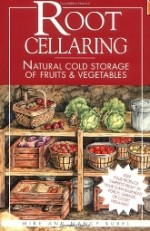 Does the thought of cantaloupe at Thanksgiving or garden tomatoes at Christmas make your mouth water? If so, you might want to consider learning the techniques of root cellaring, a low tech, energy-saving, time honored way to keep vegetables and fruits fresh long beyond their season. Using the techniques and suggestions offered by authors, Mike and Nancy Bubel, you can eat better, save money, and gain a sense of security by increasing your self-sufficiency. Whether you have a small or large garden you can benefit from root cellaring and this book will tell you how to do it.
Does the thought of cantaloupe at Thanksgiving or garden tomatoes at Christmas make your mouth water? If so, you might want to consider learning the techniques of root cellaring, a low tech, energy-saving, time honored way to keep vegetables and fruits fresh long beyond their season. Using the techniques and suggestions offered by authors, Mike and Nancy Bubel, you can eat better, save money, and gain a sense of security by increasing your self-sufficiency. Whether you have a small or large garden you can benefit from root cellaring and this book will tell you how to do it.
The book is divided into six sections. The first deals with selecting the vegetables that are the best “keepers”. It includes a list of vegetables with the names of the varieties and cultivars that have the most potential, as well as month to month suggestions for using vegetables and fruits fresh from the garden, canned, frozen, or from the root cellar.
The second and third sections discuss harvesting and preparing vegetables for the root cellar including specific instructions regarding requirements of over one hundred individual vegetables and fruits. Other foods that can be stored in a root cellar like mushrooms, eggs, and nuts are also considered. Section four gives instructions for making food storage areas for everyone and includes trenches, buried containers, and an under-the-porch root cellar. A considerable amount of information is provided for building a variety of more traditional root cellars to meet the demands of different sites and needs. A section of case histories highlights root cellaring techniques and experiences of households all over North America while a final section provides recipes that feature stored produce. The Pumpkin bisque and herring salad with apples, beets, and cabbage sound delicious! If you are interested in sauerkraut or crock pickles, you can find out how to make them too along with interesting quick breads made from sweet potatoes or pears.
Root Cellaring has a huge amount of information that is useful for extending the benefits of your vegetable and fruit produce using a root cellar or not. Learning what vegetables and fruits store best along with how to adjust your menus to the availability of food is a dynamite combinations for greater enjoyment of your homegrown produce. This is definitely NOT a coffee table book. Although the cover is colorful and appealing the black and white photos inside have little visual appeal and are informative at best. If you have any interest in storing garden produce, however, this is a must have book.
To buy Root Cellaring: Natural Cold Storage of Fruits & Vegetables from Amazon.com click here.